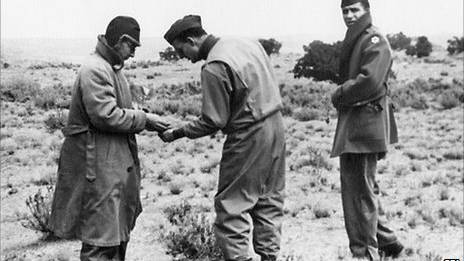Nuclear debris could reveal clues of bomb’s origin
Source: bbc.co.uk
Forensic analysis of the debris left after a nuclear explosion could yield crucial evidence about the composition and the origin of the bomb, say scientists.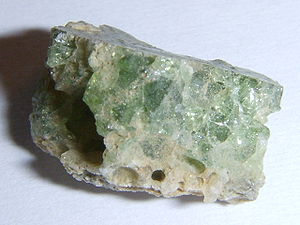 A US team examined Trinitite [right], the glassy ground debris from the first-ever nuclear test that the US Army conducted in 1945 in New Mexico.
A US team examined Trinitite [right], the glassy ground debris from the first-ever nuclear test that the US Army conducted in 1945 in New Mexico.They used advanced analytical techniques to reveal details about the materials used to construct the bomb.
The study appears in the journal PNAS.
The first atomic bomb exploded in the early hours of 16 July, 1945, in the desert near Alamogordo Air Base. Code-named "Trinity", the detonation was just a test conducted far away from any settlements.
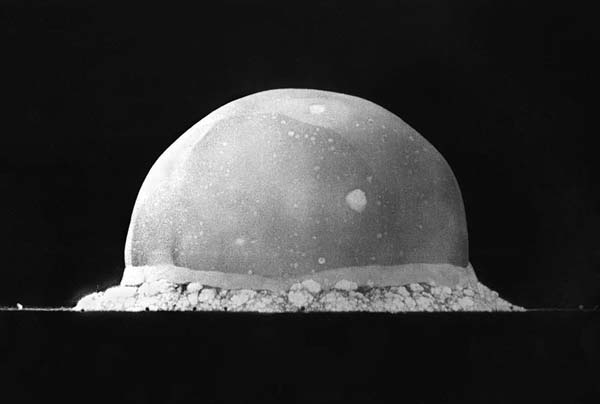
The Trinity explosion, 0.016 seconds after detonation. The fireball is about 600 feet (200 m) wide. Trees may be seen as black objects in the foreground for comparison.
Just weeks later, in the final stages of World War II, two atomic bombs were dropped on the Japanese cities of Hiroshima and Nagasaki.
Between 90,000-166,000 people died in Hiroshima and some 60,000-80,000 in Nagasaki. About half of the deaths happened on the day of the bombing.
Tracing the responsible
Now, many consider the threat of a nuclear attack by terrorists to be very real. Such an attack could potentially wipe out whole cities.
But if someone does ever undertake such an attack, could the culprits behind the bomb ever be found?
The current study’s lead author Albert Fahey, of the National Institute of Standards and Technology (Nist) in Gaithersburg, US, seems to think so.
"Prior to this, pretty much everyone assumed that everything would be vaporised, it would all be homogeneous and we would have no idea whatsoever where this thing came from," he told BBC News.
"Turns out that’s not true."
The researcher explained that his team used nuclear forensic analysis to study a little piece of trinitite that he obtained from a material collector over the internet.
The scientists were surprised to find that their "microanalysis" techniques identified the secondary materials used to build the device that went off at Trinity site.
This information, in turn, can be used to trace the bomb’s origin, he said.
"Prior to this study, people didn’t realise that other components of the bomb could be discerned from looking at ground debris and seeing what’s associated [with it]," said Dr Fahey.
"But there are some distinctive signatures that were in the bomb other than fission products and plutonium, and that gives you hope that you can get some additional information out of it - like where it was made."
Other materials
The researchers write in the paper that contrary to the nuclear material that would be likely to come from wherever a person could get it, "whether it was submitted by a state that’s sympathetic or they got it on the black market", other materials would likely be of local origin.
"The materials that go to make the rest of the bomb, to produce the critical mass, [would be] obtained from local sources," said Dr Fahey.
"Perhaps if it’s a gun-type device, an artillery barrel, maybe it was put in a shipping container so maybe there were bricks around it.
"And they’ll have records associated with them. For example, if someone were to use a lead tamper, then the isotopic composition of the lead would pinpoint or at least narrow down the number of lead mines it could come from."
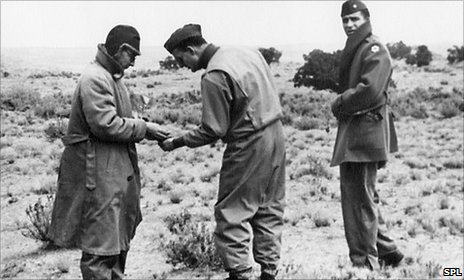
The site for the first atomic bomb test was code-named Trinity. SPL
Richard Lindstrom, also of the National Institute of Standards and Technology and a co-author of the study, told BBC News that the study was a crucial first step to help identify those behind any future nuclear terrorist attack.
"The interest that the team are trying to stir up is that here is this ancient material from 1945 that contains a tremendous amount of information that maybe we should go back and try to understand a little bit better - just in case we ever should try to infer the composition and source of a nuclear explosion from the debris of a terrorist event.
"Just from this random sample of trinitite we can draw a surprising number of conclusions about the device."
Article from: bbc.co.uk
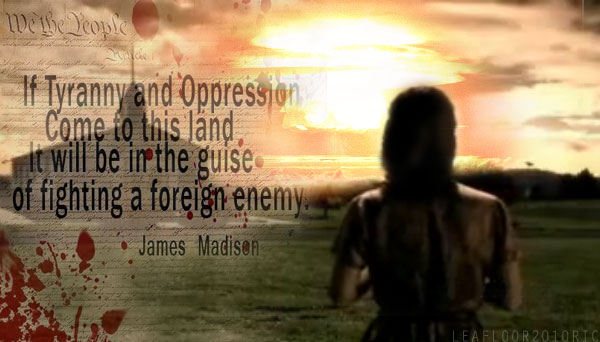
Trinity Nuclear Weapon Test (Drama)
Video from: YouTube.com
Oregon Portland Dirty Bomb Exercise Terror drill (2007)
Video from: YouTube.com
Trinity and Beyond: The Atomic Bomb Movie (1995) documentary excerpts
Video from: YouTube.com
